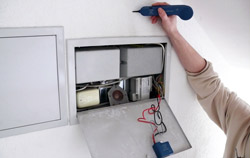PCE-191 CB is a handheld, portable wire tracer, cable detector or cable fault meter used for locating wires and cables hidden behind walls and insulation.
PCE-180 CBN is a handheld, portable, battery-powered wire tracer or cable locator that consists of an amplifier probe and acoustic signal or tone generator. This locating device is designed to detect wires or cables hidden behind walls or insulation.
The PCE-CL 20 is a cable locator used to detect live and voltage-free electrical wires. This cable detector also can be used to locate metallic and non-metallic gas or water pipes, identify short circuits, and follow lines inside walls or under flooring.
A cable locator is a practical tool for non-destructively determining the position and route of the concealed cables. Depending on what the cable locator is to be used for, there are great differences between the available models. In order to determine whether power, water or heating lines are located in a certain area, a simple cable locator with a material selector switch is often sufficient. Other types of devices make it possible to determine the exact position even of the deep-set cables, to locate short circuits or earth faults or to allocate individual cables in cable ducts or on switch cabinets.
Areas of application for cable locators
There are many compact cable locators on the market that give craftsmen and handymen a rough indication of whether there is an electrical cable, a metal pipe or profile or a wooden substructure in the ceiling, wall or floor at the location being examined. However, there are also many cable locators on offer that have been optimised for special tasks. For example, a suitable cable locator helps electricians, telephone and network technicians to assign a cable to a specific connection during new installations, repairs and extensions of systems. With the suitable cable locator, the exact position of the cable breaks or short circuits can also be found quickly and without time-consuming and costly destructive actions.
It is also often a good idea to use cable locators when working outdoors with the laid cables on public or private properties. If it is certain where which cable is located, it is usually only necessary to uncover the relevant area for repairs or new connections. This can significantly reduce the costs for uncovering and covering the cables again. In the case of the earthworks that do not affect the pipeline, prior testing with the cable locator can specifically prevent the supply lines in the affected area from being damaged by the construction work.
Selection criteria for the cable locator

Before comparing different models, it is useful to define some minimum requirements that the cable locator should meet. The following list can serve as a basis for this.
- Which cables or materials can the cable locator locate?